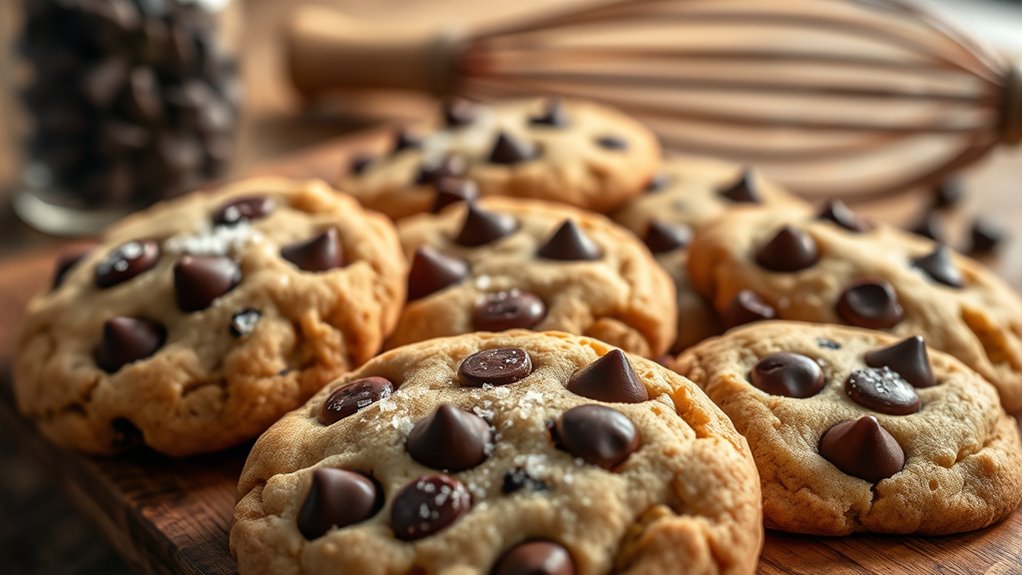You’ll need precise measurements: about 2 1/4 cups all-purpose flour, 1 tsp baking soda, 1/2 tsp salt, 1 cup softened butter, 3/4 cup sugar, 3/4 cup brown sugar, 1 tsp vanilla, 2 eggs, and 2 cups semi-sweet chocolate chips. Cream butter with sugars until fluffy, then add eggs and vanilla gradually. Incorporate sifted dry ingredients carefully to avoid overmixing. Bake at 375°F for 9–11 minutes on parchment-lined sheets. Perfect cooling and serving tips await to enhance your cookies further.
Ingredients and Quantity
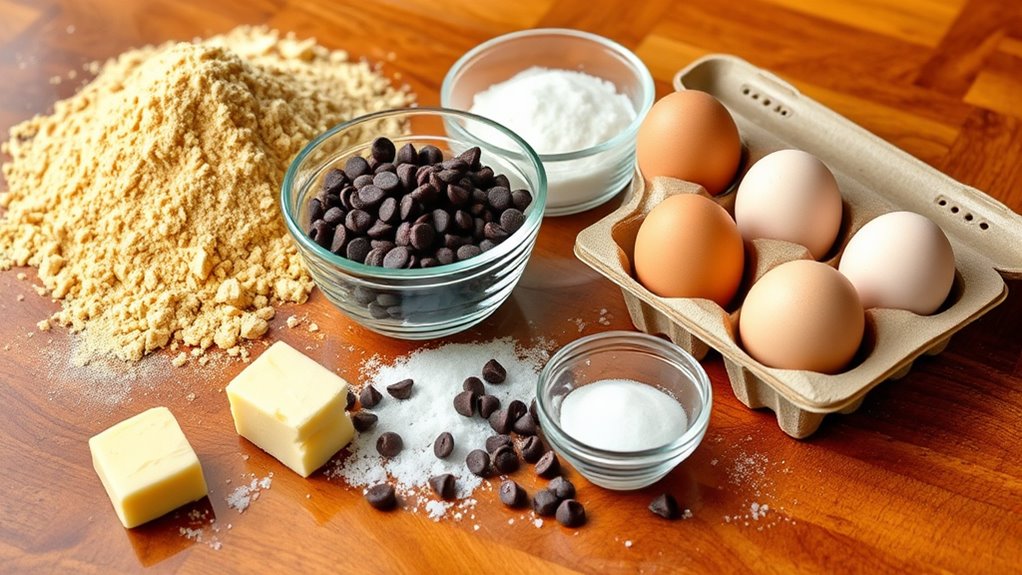
Before you begin mixing, you’ll need to gather specific ingredients in exact quantities to guarantee your chocolate chip cookies turn out perfectly. Precision in measuring accuracy is critical, especially for flour, sugar, and butter, to maintain the ideal texture and structure. Selecting the right chocolate types also impacts the final taste and melt consistency. Use semi-sweet chips for balanced sweetness or dark chocolate chunks for a richer profile.
| Ingredient | Quantity |
|---|---|
| All-purpose flour | 2 1/4 cups |
| Butter (unsalted) | 1 cup (227g) |
| Chocolate chips | 1 1/2 cups |
Ensure you use a digital scale or standardized measuring cups for consistency. This exactness gives you freedom to experiment later with confidence.
Preparations
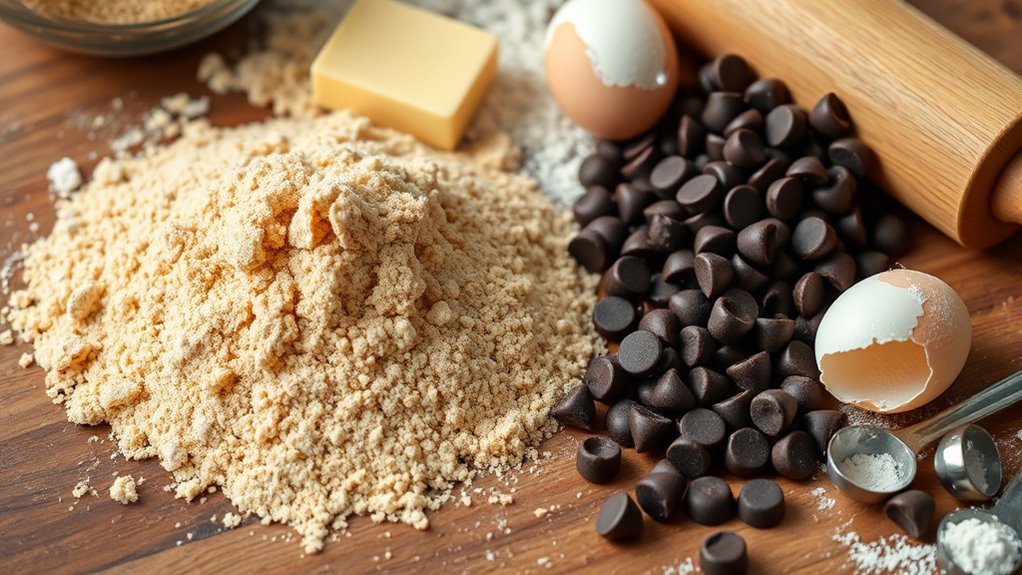
Although gathering the ingredients precisely is essential, preparing your workspace and equipment with equal care guarantees a smooth baking process. Start by sanitizing your counters and clearing clutter to maintain hygiene and prevent cross-contamination. Organize your baking equipment—mixing bowls, measuring cups, spatulas, and baking sheets—in an accessible layout to streamline workflow. Preheat your oven to the specified temperature to assure consistent baking. Line your baking sheets with parchment paper or silicone mats to prevent sticking and promote even heat distribution. Have your cooling racks ready for immediate transfer of baked cookie dough to avoid sogginess. Confirm all utensils are dry to maintain ingredient integrity. By meticulously preparing your environment and tools, you’ll enjoy unrestricted freedom to focus on crafting perfect chocolate chip cookies without interruption or delay.
How to Prepare

- Accurately measure and combine dry ingredients—flour, baking soda, and salt.
- Sift dry ingredients together to eliminate lumps and ensure uniform distribution.
- In a separate bowl, cream softened butter with sugars using a paddle attachment or hand mixer at medium speed until light and fluffy.
- Gradually incorporate eggs and vanilla extract, mixing consistently to avoid curdling.
- Slowly add the dry mixture, folding gently to preserve air pockets.
- Fold in chocolate chips or nuts, adjusting quantities for cookie variations.
- Control mixing time precisely to prevent overmixing, which develops gluten and toughens cookies.
- Follow these steps to guarantee consistent dough texture and ideal baking results while allowing customization of cookie variations.
How to Serve
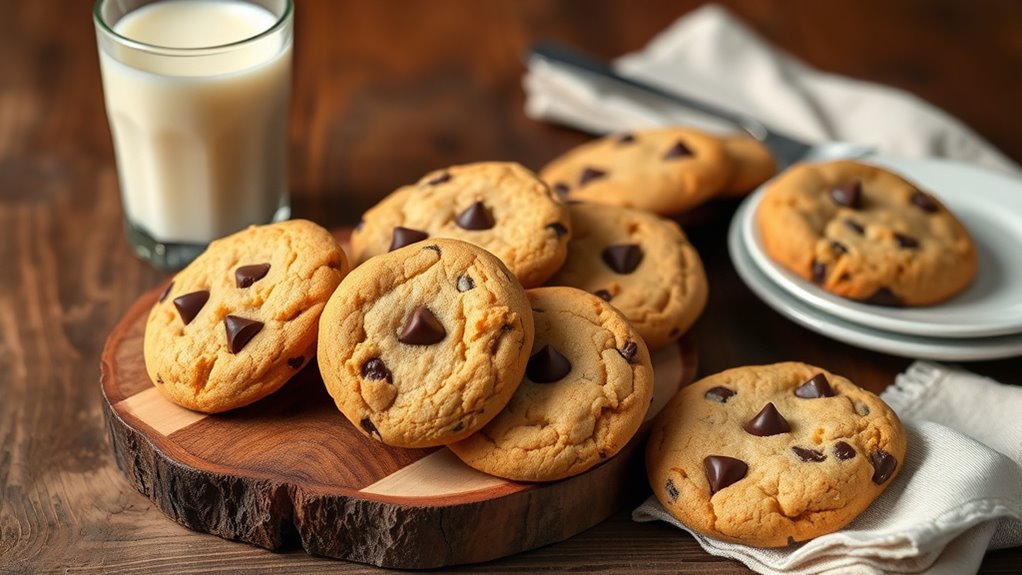
When serving chocolate chip cookies, you’ll want to guarantee they have cooled sufficiently to set their structure, typically for at least 10 minutes on a wire rack, which prevents sogginess and maintains ideal texture. For serving suggestions, consider pairing the cookies with cold milk or a scoop of vanilla ice cream to enhance contrast in temperature and flavor. Presentation ideas include arranging cookies in a neat stack or fanning them out on a decorative plate to showcase their golden edges and melty chips. You might also use parchment paper or a wooden board to add rustic charm without compromising functionality. If serving a group, provide small plates and napkins to facilitate ease and cleanliness, ensuring your guests enjoy the cookies without hassle.
Tips
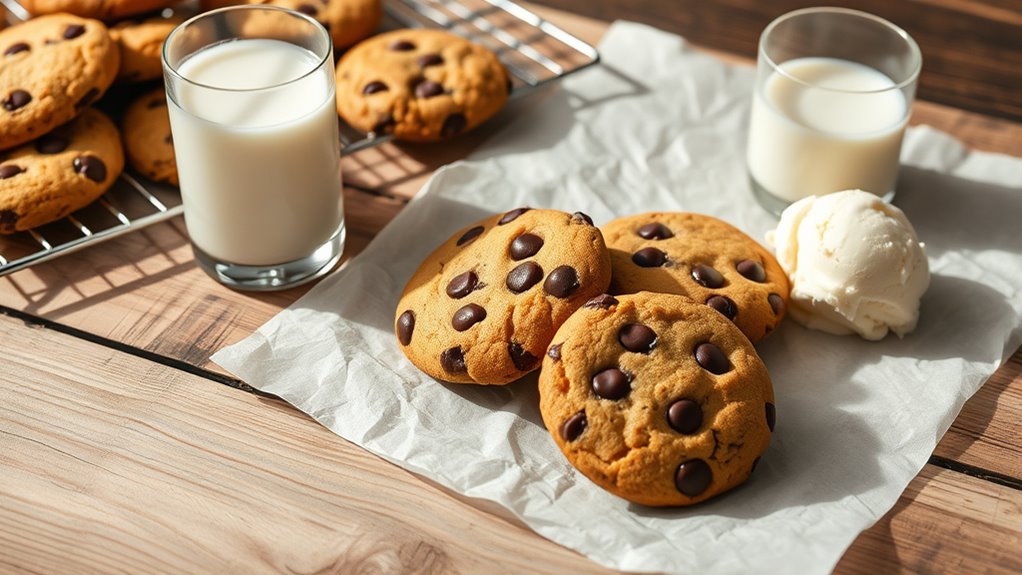
Since achieving the perfect chocolate chip cookie requires attention to multiple variables, you’ll want to carefully control ingredient temperatures, baking times, and oven calibration to guarantee consistent results. Precise baking techniques like chilling dough for at least 30 minutes improve texture by controlling spread during baking. When considering ingredient substitutions, choose alternatives with similar moisture and fat content to maintain balance—for example, swapping brown sugar with coconut sugar retains chewiness, while using melted butter instead of softened butter alters spread and crispness. Monitor oven hot spots by rotating trays halfway through baking, ensuring even heat distribution. Use an accurate oven thermometer to avoid temperature variances that affect rise and browning. Finally, avoid overmixing once flour is added; this prevents gluten overdevelopment, preserving the cookie’s tender crumb while granting you freedom to experiment with flavors confidently.
Food Value and Benefit
Chocolate chip cookies, while traditionally considered indulgent treats, provide a combination of macronutrients and micronutrients that contribute to their food value and potential benefits when consumed in moderation.
Food Value:
Each cookie contains carbohydrates, fats, and proteins, offering a balanced macronutrient profile that delivers quick energy. The sugars and simple carbohydrates provide an immediate glucose boost for cognitive and physical activities. Protein and fats present help with satiety and gradual energy release. Additionally, chocolate chips contribute antioxidants such as flavonoids.
Benefits of Eating Chocolate Chip Cookies:
- Provide quick energy through carbohydrates.
- Supply moderate amounts of protein and fat for sustained energy and fullness.
- Contain antioxidants from chocolate chips that may support overall health.
- Offer a source of certain vitamins and minerals that contribute to nutrition.
Vitamins and Minerals Present:
- Vitamin B6: Supports metabolism and brain health.
- Iron: Important for oxygen transport in the blood.
- Magnesium: Involved in muscle and nerve function.
- Potassium: Helps regulate fluid balance and muscle contractions.
- Calcium: Supports bone health (from dairy ingredients).
